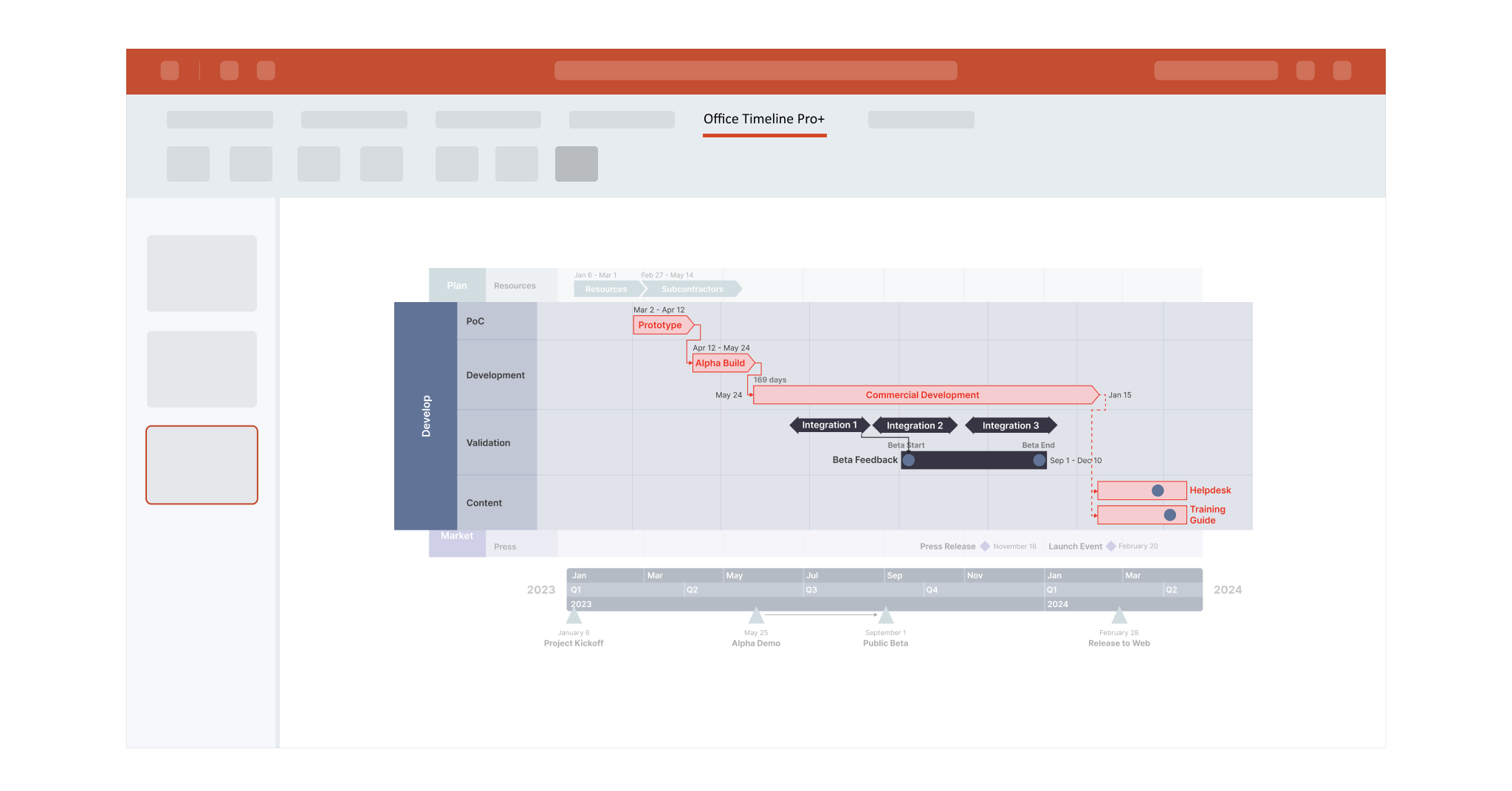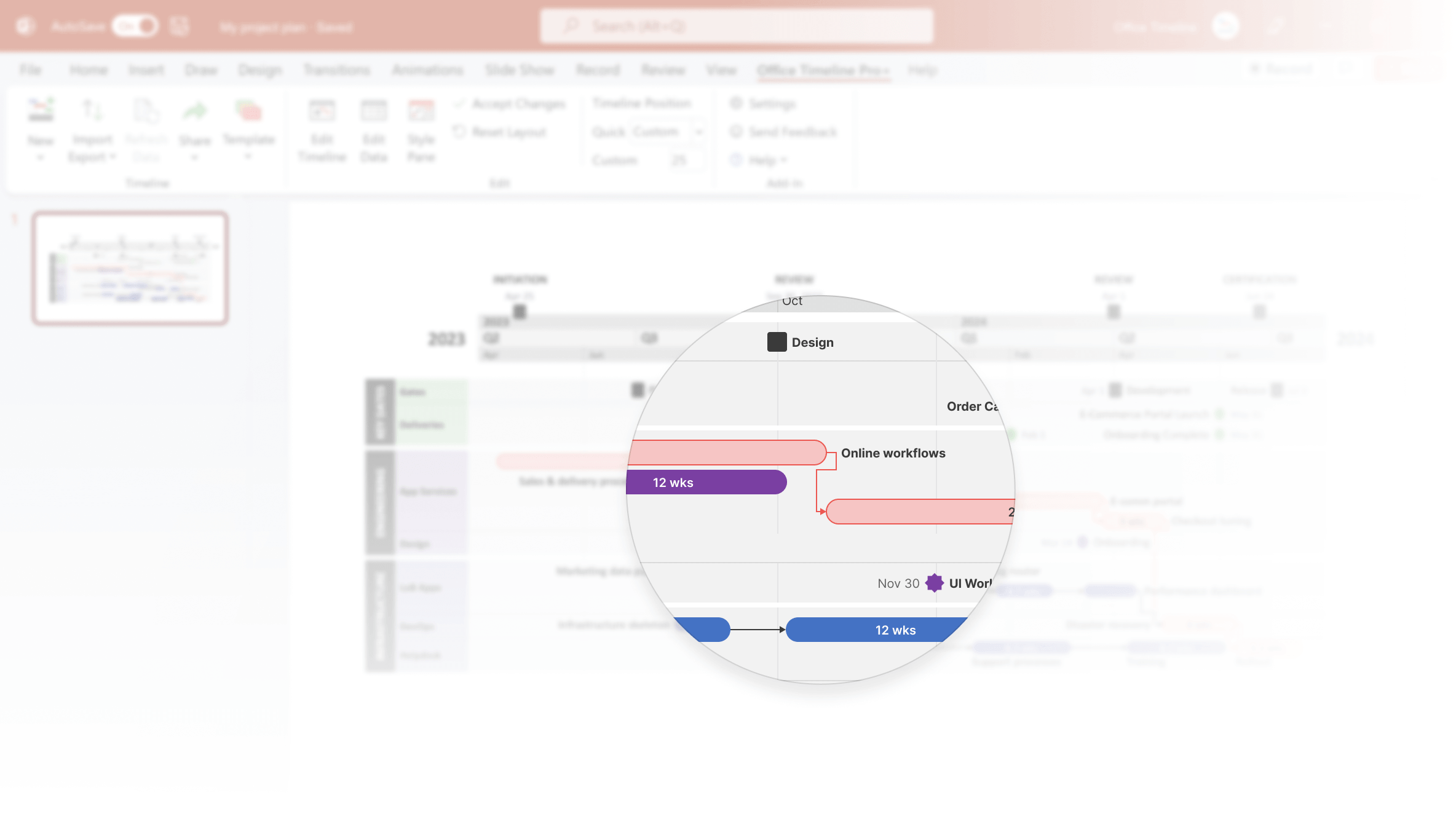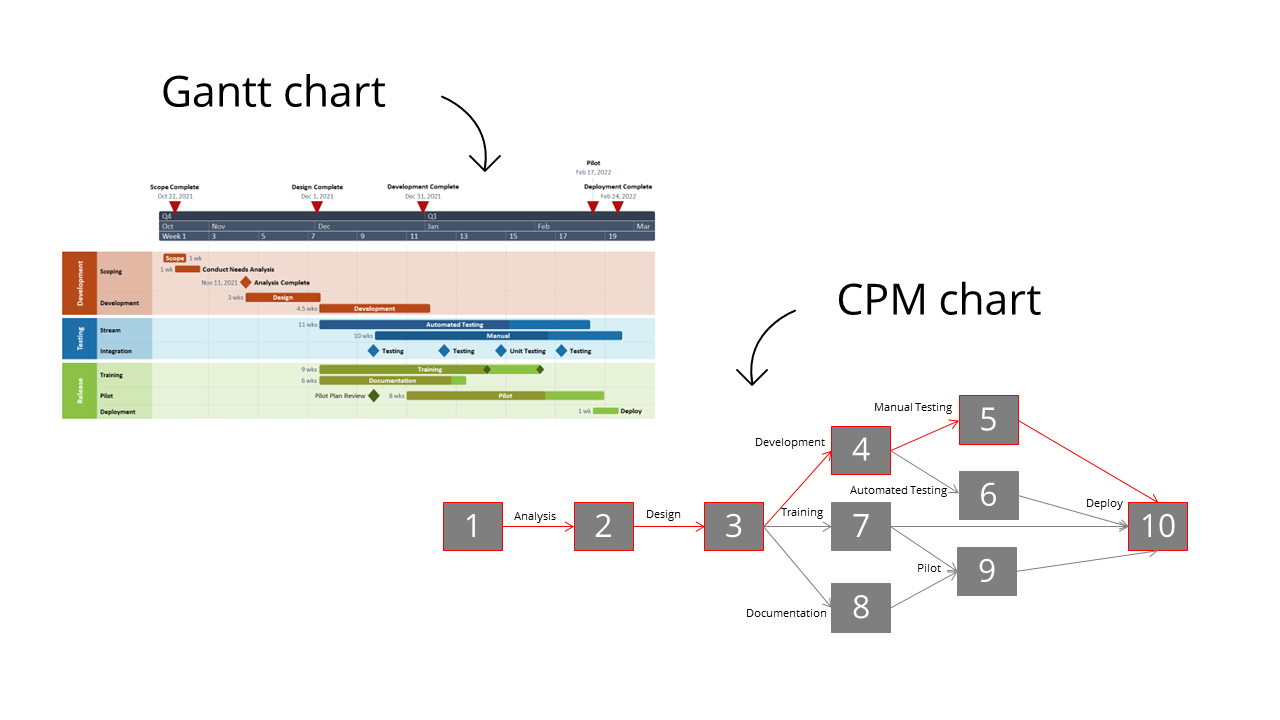Critical Path Method (CPM) – how to use it in project management
A summary introduction to the critical path method

Definitions of critical path, project dependencies, and critical path method
If leveraged properly, the critical path method (CPM) can become a particularly useful asset in project management, especially when it comes to planning tasks and managing resources. By mapping out the key activities necessary to complete a project into a sequence called critical path, this technique helps project managers effectively monitor task dependencies and set realistic timeframes.
What is the critical path of a project?
The critical path in project management is the longest stretch of essential tasks that must be finished on time to successfully complete a project. When added together, these tasks will determine how long the project will take to be delivered. This is why they are called critical activities - if they are delayed, the completion of the whole project will be delayed.
Identifying the critical path thus helps project managers to:
-
Accurately estimate the overall duration of a project.
-
Clearly pinpoint task dependencies, resource constraints, and project risks.
-
Better prioritize tasks and create realistic project schedules.
What are dependencies in project management?
Project dependencies, also known as task dependencies, represent relationships between tasks that determine the sequence of work in a project. Dependent tasks require one or more other activities to be started or finished before the team can begin working on them.
The four main types of project or task dependencies are:
Finish to Start – task A must finish before task B can begin. For example, a fabrication team cannot proceed with building a product until its final design has been approved.
Start to Start – this scenario requires task A to start before the task B can begin. For example, a content writer cannot revise an article draft until the editor has started to edit it.
Finish to Finish – in a finish-to-finish dependency, task B cannot finish until task A has finished. For example, a server cannot finish serving everyone at a particular table until the chef has finished preparing each ordered dish.
Start to Finish – in this case, task A cannot finish until task B has started. For example, the morning shift working in a hotel cannot finish their day until the evening shift has arrived and started their own.
Because task dependencies can affect project budgets, schedules, resources, and risks, it is important for project managers to highlight them early in the planning process.
What is the Critical Path Method (CPM)?
The critical path method (CPM) is a project management technique that helps professionals create a project schedule and estimate the total duration of a project. It involves discovering the most important tasks in a project’s timeline, identifying task dependencies, and calculating task durations to determine scheduling flexibilities.
Developed in the late 1950s as an algorithm to solve the issue of increased costs caused by inefficient scheduling, the critical path method is also known as critical path analysis (CPA). When applied correctly, CPA yields a clear network diagram that visually represents the series of tasks needed to successfully deliver an initiative and estimates the shortest duration possible for this outcome.
Here are some key concepts for the critical path method:
Earliest start time (ES) – the earliest time that a task can be initiated in your project. You cannot establish this without any task dependencies first.
Latest start time (LS) – the very last moment in which you can start a task without the risk of delaying the project schedule.
Earliest finish time (EF) – the earliest that an activity can be completed, taking into account its duration and earliest start time.
Latest finish time (LF) – the latest that an activity can be finished, based on its duration and latest start time.
-
Slack – also known as float, this refers to how long you can delay a task before it negatively affects its task sequence and the overall project schedule; in other words, slack is the time between the soonest date a task can be finished and the latest date it must be finished.
The tasks on the critical path have zero slack/float because they can’t be delayed. However, there are some activities that are not as time constrained as others and which will not jeopardize the project completion date if they are finished a bit later than their planned dates. The latter type of tasks can receive a float or slack value.
Why use the critical path method?
A powerful project management tool, the critical path method provides valuable insight into how you can effectively plan complex initiatives, allocate resources, and optimize corresponding timelines.
Here are the main benefits of using CPM:
It visualizes dependencies – the critical path diagram that results from applying CPM shows how tasks are interconnected, which facilitates a better prioritization of tasks and understanding of what to expect in any CPM-driven process.
It reduces delays – by identifying the most important sequence of tasks in a project, project managers can optimize the work along the critical path, thus proactively preventing delays.
It improves organization – within complex projects, CPM helps break down deliverables into sequences, and sequences into individual actionable steps. Thus, all the work involved becomes more manageable, and drastically improves project organization.
It optimizes efficiency – with a clearly mapped out critical path, project managers have a better idea of what needs to be done. Using this information, they can allocate resources more efficiently, adding or removing assets based on the task’s importance.
It allows the accurate estimation of each task’s duration, as well as float calculation – knowing how much a task can be delayed without impacting the project schedule, you can make informed decisions on how to better distribute resources and prepare for unforeseen issues that may arise.
It improves future planning – CPM helps you compare expectations versus actual progress and provides data that can be used to inform future project plans.
Examples of Critical Path Analysis
To help you grasp the meaning of a critical path for a project schedule, we have included a few examples of critical path diagrams below.
Critical Path Schedule – Example

The schedule above shows project management teams which tasks are on the critical path. Out of the seven tasks on the schedule, Prototyping and Integration Testing are not on the critical path. The tasks (red) that are on the critical path will determine the end date of the project.
Critical Path Chart – Example 2

By highlighting how tasks are dependent on others, this diagram helps you better understand the order in which certain activities need to happen, and what tasks can be performed concurrently. As you can see, there are multiple possible paths towards the end of the project, but only path 3 is the critical one as it shows the minimum duration for completing all of the project’s tasks.
Critical Path Diagram – Example 3

The example above, which was inspired from a Harvard Business Review article, displays the critical path schedule for the construction of a house. Each shape in the CPM diagram represents an activity, along with its duration, whereas the red arrows connect the critical path tasks.
How to find the critical path using CPM
The best way for project managers to identify and illustrate a project’s critical path is to create a critical path diagram. This type of visual project management chart will show which tasks are dependent on others before they can begin, and also the ones that can happen at the same time. There will be multiple paths to completion, but only one of them will lead to the project’s delivery in the shortest amount of time.
Below is a breakdown of the main steps necessary to find the critical path in a project:
List activities - create a work breakdown structure to identify all the project activities required to produce the deliverables.
Identify task dependencies - using the work breakdown structure from Step 1, define how various tasks depend on one another. These dependencies will outline the activity sequence that lies at the basis of your critical path.
Create a network diagram - turn your work breakdown structure into a flowchart that displays the chronology of your activities. Use boxes to represent tasks and arrows to depict any interdependencies. You will add other time-bound components to the diagram once you figure out the whole project schedule.
Estimate task durations - estimate how long each activity will take to be completed using start and end dates as reference points.
Calculate the critical path - look at the durations of your activities and determine the duration of the entire sequence which they are part of. The sequence of activities with the longest duration is your critical path. Optionally, this step can include the calculation of slack. To determine the amount of flexibility of a give task, use the following formula: Slack = LS – ES.
Update the critical path - revise and continue to update the critical path network diagram as the process goes through the execution phase.
If you need examples and more details about the process above, check out our dedicated post on how to find a project’s critical path.
How to choose the best critical path software
Originally done by hand, calculating the critical path of a project is indeed no easy task for a project manager. Fortunately, various critical path software options have emerged as the better alternative to the manual process.
To help you choose the best fit for you, let’s have a brief look at some of the main features that such dedicated project management tools should have:
Dependencies - the solution you choose should allow you to connect any interdependent project tasks in an easy-to-follow way so you can efficiently avoid bottlenecks.
Gantt chart functionality - this will help you both plan and schedule in one place. Your choice of software should let you add tasks, start and end dates, as well as durations, and automatically generate a project timeline which gives an overview of your project at a glance.
Planned versus actual baselines - once you finish creating the project schedule, complete with start dates and deadlines, the capability of setting baselines will help you compare your captured data against actual progress.
Dashboards - this will enable you to get a high-level snapshot of your project’s components and progress at various moments along your project’s lifecycle.
Ability to update data in real time - with a good critical path analysis system, you will be able to easily update your data as changes occur in your plans. Thus, you avoid working with outdated information and ensure project execution is on track.
Get access to more resources on the tools that can help you generate critical paths with our review of the top 6 critical path analysis software.
Free critical path templates to streamline your project management
Save time and effort in determining the critical path of your project with our free, reusable critical path method templates. By easily customizing any of these pre-formatted samples, you can:
View which tasks have the biggest impact on your project timeline.
Display project deliverables in a clear, easy-to-follow format.
Effectively identify and track project dependencies.
Instantly update your project timeline as your team completes and adjusts tasks, or if circumstances change.
Give executives and stakeholders visibility into the project’s progress and priorities.
Frequently asked questions about the critical path method
Here are the answers to the most commonly asked questions about the critical path method.
What is critical path in project management?
In project management, the critical path refers to the longest sequence of tasks that must be finished for the entire project to be complete. A delay in any of these activities will result in a delay of the whole project.
As an example, let’s consider the simple process of making an omelet. If we were to create a short recipe for it, it would involve the following core steps:
Beat x eggs.
Heat a pan, add butter/oil when hot.
Pour in beaten eggs and cook for 5 minutes.
There are other actions you can perform in the process, such as seasoning the eggs with salt and pepper, adding cheese or some vegetables. However, these activities are additional when compared to the three steps above, which are crucial and non-skippable. They represent the critical path of this particular initiative.
What is the primary key?
The primary key step of the critical path method consists in identifying all the activities that make up the work breakdown structure of your project. It is the first out of the six main steps of finding a project’s critical path.
What are dependencies?
Project dependencies, also called task dependencies, are relationships between a project’s activities that determine the sequence of work in that project. To define any dependencies, you should answer the following questions:
Which task must happen before a specific task occurs?
Which task needs to be finished at the same time as another given task?
Which task happens directly after another particular task?
Depending on the answers to these questions, 4 major types of task dependencies can result, as illustrated below:
How is CPM different from Gantt chart?
Both CPM and Gantt charts show the dependencies between the tasks of a project. However, the two mainly differ in that the CPM maps the sequence of tasks that determine a project’s duration, whereas the Gantt chart offers a timeline view of a project.
Find a summary of the differences between these two important project management tools below:
CPM
Illustrates critical and non-critical paths and calculates project duration.
Has the layout of a network diagram with linked boxes.
Doesn’t display the required resources.
Usually plots activities on a network diagram without a defined timescale.
Gantt chart
Visualizes how project tasks are progressing.
Has the layout of a horizontal bar chart.
Shows resources required for each activity.
Displays activities on a timescale.
Where is the critical path method used?
The CPM is very commonly used in the management of construction projects which have a single value-delivery event, such as the completion of a building. It can also prove useful in large, complex projects where monitoring numerous tasks tends to become overwhelming. In such cases, this project management technique can be a lifesaver as it allows project managers to better prioritize work and resources.
CPM doesn’t perform so well in projects where there are unknowns about the overall plan (the final objective isn’t clear yet, tools and tactics required to get there aren’t known to the team). In such situations, it would be better to use more agile project management methods.
For more practical examples of how various types of projects can apply CPM, see our blog post on use cases of the critical path method.
How is the critical path method calculated?
Calculating the critical path of a project is a process that comprises six key steps. These are:
Listing all the activities required to produce the project’s deliverables.
Delineating any dependencies between the activities/tasks identified in Step 1.
Creating a CPM network diagram.
Estimating the duration (completion time) for each of your tasks.
Identifying the longest activity sequence that needs to happen in order for the project to be complete.
Updating the critical path network diagram as project work progresses.
For a more comprehensive illustration of what each of the steps above entails, read our post on how to identify a project’s critical path.
To save time in accurately highlighting project dependencies and estimating task durations, you can use dedicated critical path software. One such solution is Office Timeline, a lightweight PowerPoint add-in that helps you automatically generate crisp, clear critical path diagrams which you can easily update and include in important presentations.
Start scheduling projects now
Easily create and show dependencies and critical paths for your project plans with Office Timeline. Generate stylish roadmaps, Gantt charts and other project visuals with just a few clicks.






